
The Siberian Husky is a medium-sized working sled dog breed. The breed belongs to the Spitz genetic family. It is recognizable by its thickly furred double coat, erect triangular ears, and distinctive markings, and is smaller than the similar-looking Alaskan Malamute.

The Shiba Inu is a breed of hunting dog from Japan. A small-to-medium breed, it is the smallest of the six original and distinct spitz breeds of dog native to Japan.

A 'dog breed' is a particular strain or dog type that was purposefully bred by humans to perform specific tasks, such as herding, hunting, and guarding. When distinguishing breed from type, the rule of thumb is that a breed always "breeds true". Dogs are the most variable mammal on earth, with artificial selection producing around 450 globally recognized dog breeds. These breeds possess distinct traits related to morphology, which include body size, skull shape, tail phenotype, fur type, and coat colour. Their behavioural traits include guarding, herding, and hunting, and personality traits such as hypersocial behavior, boldness, and aggression. Most breeds were derived from small numbers of founders within the last 200 years. As a result, today dogs are the most abundant carnivore species and are dispersed around the world.

The Bulldog, also known as the English Bulldog or British Bulldog, is a medium-sized dog breed. It is a muscular, hefty dog with a wrinkled face and a distinctive pushed-in nose. The Kennel Club (UK), the American Kennel Club (US), and the United Kennel Club (US) oversee breeding records. Bulldogs are popular pets; they were the fifth most popular purebreed in the US in 2017 according to the American Kennel Club.

The Newfoundland is a large working dog. They can be either black, brown, grey, or white-and-black. However, in the Dominion of Newfoundland, before it became part of the confederation of Canada, only black and Landseer coloured dogs were considered to be proper members of the breed. They were originally bred and used as working dogs for fishermen in Newfoundland. Newfoundlands are known for their giant size, intelligence, tremendous strength, calm dispositions, and loyalty. They excel at water rescue/lifesaving because of their muscular build, thick double coat, webbed paws, and swimming abilities.

A working dog is a dog used to perform practical tasks, as opposed to pet or companion dogs.

The French Bulldog is a breed of domestic dog, bred to be companion dogs. The breed is the result of a cross between Toy Bulldogs imported from England, and local ratters in Paris, France, in the 1800s. They are stocky, compact dogs with a friendly, mild-mannered temperament.

The Golden Retriever is a medium-large gun dog that was bred to retrieve shot waterfowl, such as ducks and upland game birds, during hunting and shooting parties. The name "retriever" refers to the breed's ability to retrieve shot game undamaged due to their soft mouth. Golden retrievers have an instinctive love of water, and are easy to train to basic or advanced obedience standards. They are a long-coated breed, with a dense inner coat that provides them with adequate warmth in the outdoors, and an outer coat that lies flat against their bodies and repels water. Golden retrievers are well suited to residency in suburban or country environments. They shed copiously, particularly at the change of seasons, and require fairly regular grooming. The Golden Retriever was originally bred in Scotland in the mid-19th century.

Aethes is a genus of moths belonging to the subfamily Tortricinae of the family Tortricidae.

Bactra robustana is a moth belonging to the family Tortricidae. The species was first described by Hugo Theodor Christoph in 1872.
Epiblema grandaevana is a moth, belonging to the family Tortricidae. The species was first described by Friederike Lienig and Philipp Christoph Zeller in 1846.
Epiblema inulivora is a moth belonging to the family Tortricidae. The species was first described by Edward Meyrick in 1932.
Epiblema similana is a moth belonging to the family Tortricidae. The species was first described by Michael Denis and Ignaz Schiffermüller in 1775.
Epiblema abruptana is a moth belonging to the family Tortricidae. The species was first described by Lord Walsingham in 1879.
Epiblema absconditana is a moth belonging to the family Tortricidae. The species was first described by Jean Jacques Charles de La Harpe in 1860.
Epiblema albohamulana is a moth belonging to the family Tortricidae. The species was first described by Hans Rebel in 1893.

Ancylis unguicella is a moth belonging to the family Tortricidae. The species was first described by Carl Linnaeus in his landmark 1758 10th edition of Systema Naturae.
Epiblema arizonana is a moth belonging to the family Tortricidae. The species was first described by Powell in 1975.










